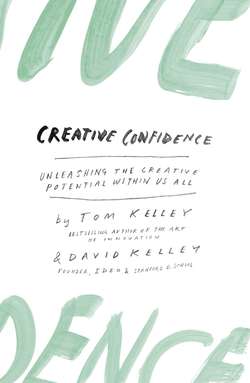Читать книгу Creative Confidence: Unleashing the Creative Potential Within Us All - David Kelley - Страница 10
CREATIVITY NOW
ОглавлениеCreativity is much broader and more universal than what people typically consider the “artistic” fields. We think of creativity as using your imagination to create something new in the world. Creativity comes into play wherever you have the opportunity to generate new ideas, solutions, or approaches. And we believe everyone should have access to that resource.
For much of the twentieth century the so-called “creative types”—designers, art directors, copy writers—were relegated to the kids’ table, far from serious discussions. Meanwhile, all the important business conversations took place among the “grown-ups” in boardrooms and meeting spaces down the hall.
But the creative endeavors that seemed fanciful or extracurricular a decade ago have now gone mainstream. Education thought leader Sir Ken Robinson—whose riveting 2006 TED Talk asking “Do Schools Kill Creativity?” was the most popular in history—says that creativity “is as important in education as literacy, and we should treat it with the same status.”
In the business world, creativity manifests itself as innovation. Tech stars such as Google, Facebook, and Twitter have unleashed their employees’ creativity to change the lives of billions of people. Today, in every department—from customer service to finance—people have opportunities to experiment with new solutions. Companies desperately need employees’ insights from across the organization. No individual executive or division holds a monopoly on new ideas.
Whether you live in Silicon Valley or Shanghai, Munich or Mumbai, you’ve already felt the effects of seismic market shifts. Most businesses today realize that the key to growth, and even survival, is innovation. One recent IBM survey of more than 1,500 CEOs reports that creativity is the single most important leadership competency for enterprises facing the complexity of global commerce today. An Adobe Systems poll of five thousand people on three continents reports that 80 percent of people see unlocking creative potential as key to economic growth. Yet only 25 percent of these individuals feel that they’re living up to their creative potential in their own lives and careers. That’s a lot of wasted talent.
How might we shift that balance? How might we help the other 75 percent unleash their creative potential?
In 2005, David founded the d.school (formally known as the Hasso Plattner Institute of Design) to teach design thinking—a methodology for innovating routinely—to future entrepreneurs from Stanford’s graduate schools. Originally, we thought that the primary challenge would be to teach creativity to people who saw themselves as “analytical types.” We soon realized that all of the individuals we worked with already had creativity in spades.* Our job was simply to help them recapture it by sharing new skills and mindsets.
We have been stunned at how quickly people’s imagination, curiosity, and courage are renewed with just a small amount of practice and encouragement.
For the people we’ve worked with, opening up the flow of creativity is like discovering that you’ve been driving a car with the emergency brake on—and suddenly experiencing what it feels like when you release the brake and can drive freely. We see this a lot with executives during workshops, or when we have clients in to collaborate side by side with us. They’ve sat through seminars about innovation before, and they are convinced they know how creative—or how uncreative—they’re going to be. So when we get to a point that’s fuzzy or unconventional—like doing an improv exercise—suddenly they whip out their smartphones, heading for the exits to make “really important” phone calls.
Why? Because they are insecure about their abilities in that setting. They instinctively fall back on the defense that “I’m just not the creative type.”
In our experience, everybody is the creative type. We know that if we can get individuals to stick with the methodology a while, they will end up doing amazing things. They come up with breakthrough ideas or suggestions and work creatively with a team to develop something truly innovative. They surprise themselves with the realization that they are a lot more creative than they had thought. That early success shakes up how they see themselves and makes them eager to do more.
What we’ve found is that we don’t have to generate creativity from scratch. We just need to help people rediscover what they already have: the capacity to imagine—or build upon—new-to-the-world ideas. But the real value of creativity doesn’t emerge until you are brave enough to act on those ideas. That combination of thought and action defines creative confidence: the ability to come up with new ideas and the courage to try them out.
Geshe Thupten Jinpa, who has been the Dalai Lama’s chief English translator for more than twenty years, shared an insight with us recently about the nature of creativity. Jinpa pointed out that there’s no word in the Tibetan language for “creativity” or “being creative.” The closest translation is “natural.” In other words, if you want to be more creative, you just have to be more natural. We forget that back in kindergarten, we were all creative. We all played and experimented and tried out weird things without fear or shame. We didn’t know enough not to. The fear of social rejection is something we learned as we got older. And that’s why it’s possible to regain our creative abilities so swiftly and powerfully, even decades later.
It turns out that creativity isn’t some rare gift to be enjoyed by the lucky few—it’s a natural part of human thinking and behavior. In too many of us it gets blocked. But it can be unblocked. And unblocking that creative spark can have far-reaching implications for yourself, your organization, and your community.
We believe that our creative energy is one of our most precious resources. It can help us to find innovative solutions to some of our most intractable problems.
